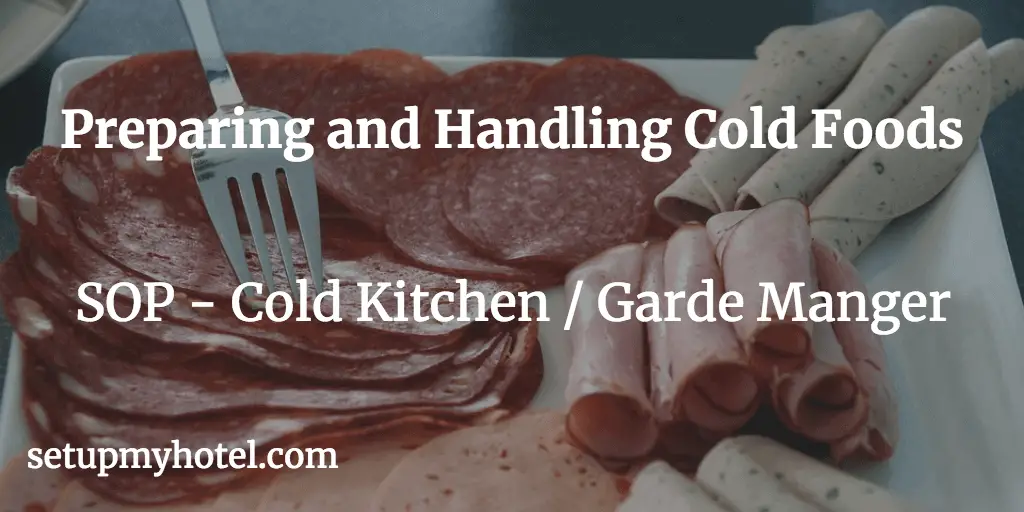Preparing and Handling Cold Foods in the Hotel Kitchen
In any food and beverage (F&B) establishment, it is crucial to maintain high standards of hygiene and safety when it comes to food preparation and handling. This is particularly the case with cold foods, which can be susceptible to bacterial growth if not handled correctly.
The temperatures of all potentially hazardous cold food should be taken during preparation to ensure the safety of all food served to the customer are safe and as per the standard practice.
To ensure that cold foods are prepared and handled safely, it is important to follow standard operating procedures (SOPs) that have been put in place. These SOPs should cover everything from the equipment and utensils used to the temperature at which foods are stored.
One key step in preparing and handling cold foods is to ensure that all equipment and utensils are clean and sanitized before use. This includes everything from knives and cutting boards to refrigerators and freezers. It is also important to ensure that all foods are stored at the proper temperature, which is typically below 41°F (5°C).
Another important aspect of preparing and handling cold foods is to ensure that foods are not left out at room temperature for extended periods of time. This can promote the growth of harmful bacteria and lead to foodborne illness. In general, it is recommended that cold foods be consumed within two hours of being prepared.
By following proper SOPs and guidelines for preparing and handling cold foods, F&B establishments can ensure that their customers are served safe and delicious meals.
The Executive Chef and Garde Manger chef or Cold Kitchen Chef should be responsible for ensuring that the cold foods are prepared using appropriate practices and procedures to ensure safety and sanitation. The hotel management should develop and implement proper written Kitchen SOP’s to ensure the same is implemented correctly throughout all the food preparation outlets.
Cold Food Preparation Standard Procedures:
- Always wash your hands before preparing or getting in contact with the food.
- Use a clean, sanitized, and calibrated thermometer to take the temperatures of potentially hazardous food products.
- Wipe the clean and sanitized thermometer stem with alcohol wipes before taking the temperatures of each food.
- Open the sanitiser package with clean hands.
- Record temperatures in the service Temperature Record log book.
- The temperature of the walk-in and deep freezer should be maintained at 0° to – 10°F.
- All items in the freezer must stay sealed or the product will become freezer burned.
- Once any food item has been thawed, even partially, it should not be re-frozen again.
- Only remove products from the freezer that will be used promptly.
- Do not pack boxes and containers in the freezer too tightly together.
- Leave enough space so that cold air can circulate freely.
- Packages packed too tightly in the freezer can cause the contents to defrost.
Points to note while preparing cold foods?
- Always pre-chill ingredients for foods that need to be served cold like sandwiches and salads to below 5°C before combining.
- Make sure to discard thawed potentially hazardous foods that have been above 5°C for more than four hours.
- Make sure to discard cold potentially hazardous food after four hours if they have not been properly held below 5° CelsiusCelsius - The thermometric scale on which 0� Celsius is the freezing point and 100� Celsius is t....
How to maintain food contact surfaces?
- Always use color-coded cutting boards for all products.
- Use cutting boards according to their colour code; Green Cutting Board = Vegetables Only, Red Cutting Board = Meat Only, Yellow Cutting Board = Chicken Only, White Cutting Board = Fish Only.
- All food contact surfaces like tables etc. should be smooth, able to be easily cleaned and sanitized, and made with the appropriate material.
- Clean and sanitize all food contact surfaces before and after use.
- Cleaning and sanitizing steps need to be done separately to be effective.
How to hold Cold Foods?
- On Regular intervals, the Garde Manger chef or Cold Kitchen Chef should check the internal temperature of food using a thermometer.
- Cold food must be held at an internal temperature of 40°F (5°C) or colder.
- Only use cold-holding equipment that can keep food at proper temperatures.
- Do not store food directly on the ice except for whole fruit and raw cut vegetables are the only exceptions.
- Place the food in pans or on the plates first before placing them on ice.
Training Summary questions:
Q1. What is the purpose of this SOP?
Q2. Who is responsible to check and monitor the cold kitchen?
Q3. Points to note while preparing cold foods?
Q4. How to maintain cold food contact surface?
Q5. How to properly hold prepared cold foods in Garde Manger?
Patreon Only SOP Download
SOP Number: Kitchen / F&B Production SOP – 11 Department: Kitchen / Food Production - Cold Food Preparation Date Issued: 30-Sep-2018 Time to Train: 30 Minutes












